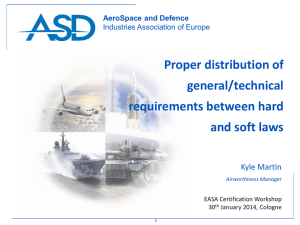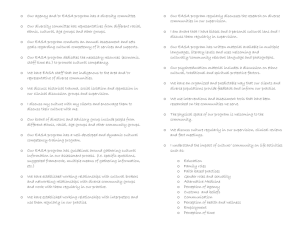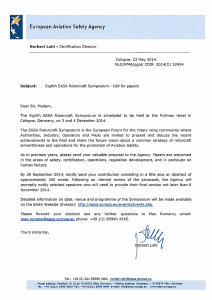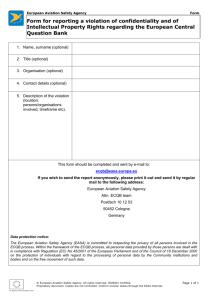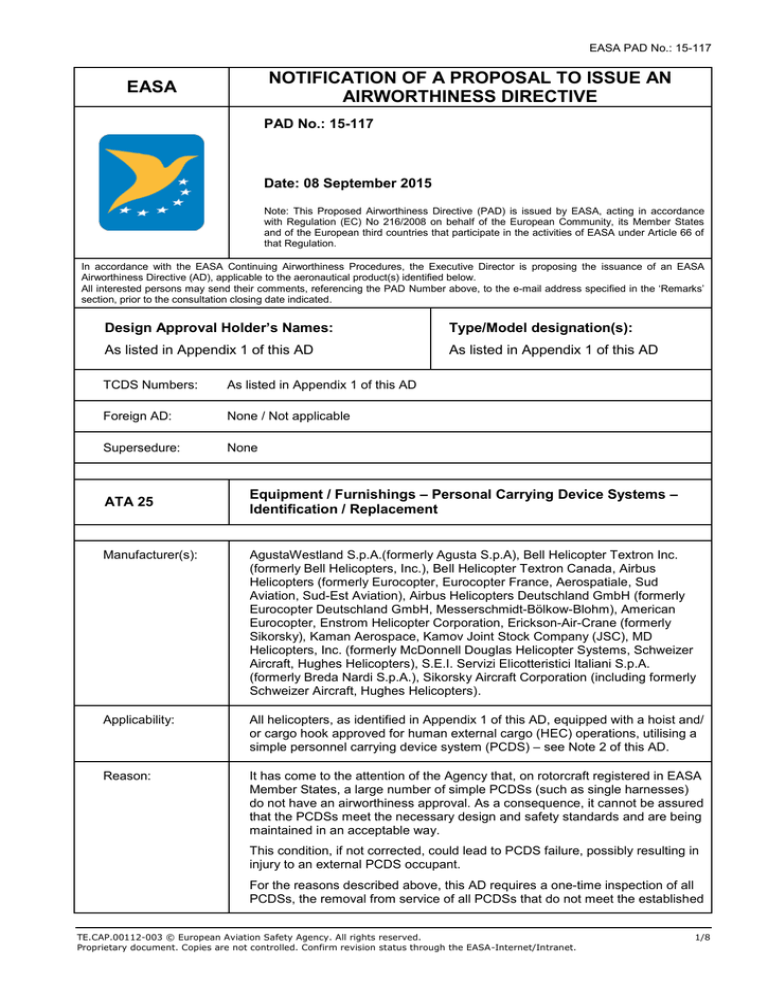
EASA PAD No.: 15-117
NOTIFICATION OF A PROPOSAL TO ISSUE AN
AIRWORTHINESS DIRECTIVE
EASA
PAD No.: 15-117
Date: 08 September 2015
Note: This Proposed Airworthiness Directive (PAD) is issued by EASA, acting in accordance
with Regulation (EC) No 216/2008 on behalf of the European Community, its Member States
and of the European third countries that participate in the activities of EASA under Article 66 of
that Regulation.
In accordance with the EASA Continuing Airworthiness Procedures, the Executive Director is proposing the issuance of an EASA
Airworthiness Directive (AD), applicable to the aeronautical product(s) identified below.
All interested persons may send their comments, referencing the PAD Number above, to the e-mail address specified in the ‘Remarks’
section, prior to the consultation closing date indicated.
Design Approval Holder’s Names:
Type/Model designation(s):
As listed in Appendix 1 of this AD
As listed in Appendix 1 of this AD
TCDS Numbers:
As listed in Appendix 1 of this AD
Foreign AD:
None / Not applicable
Supersedure:
None
ATA 25
Equipment / Furnishings – Personal Carrying Device Systems –
Identification / Replacement
Manufacturer(s):
AgustaWestland S.p.A.(formerly Agusta S.p.A), Bell Helicopter Textron Inc.
(formerly Bell Helicopters, Inc.), Bell Helicopter Textron Canada, Airbus
Helicopters (formerly Eurocopter, Eurocopter France, Aerospatiale, Sud
Aviation, Sud-Est Aviation), Airbus Helicopters Deutschland GmbH (formerly
Eurocopter Deutschland GmbH, Messerschmidt-Bölkow-Blohm), American
Eurocopter, Enstrom Helicopter Corporation, Erickson-Air-Crane (formerly
Sikorsky), Kaman Aerospace, Kamov Joint Stock Company (JSC), MD
Helicopters, Inc. (formerly McDonnell Douglas Helicopter Systems, Schweizer
Aircraft, Hughes Helicopters), S.E.I. Servizi Elicotteristici Italiani S.p.A.
(formerly Breda Nardi S.p.A.), Sikorsky Aircraft Corporation (including formerly
Schweizer Aircraft, Hughes Helicopters).
Applicability:
All helicopters, as identified in Appendix 1 of this AD, equipped with a hoist and/
or cargo hook approved for human external cargo (HEC) operations, utilising a
simple personnel carrying device system (PCDS) – see Note 2 of this AD.
Reason:
It has come to the attention of the Agency that, on rotorcraft registered in EASA
Member States, a large number of simple PCDSs (such as single harnesses)
do not have an airworthiness approval. As a consequence, it cannot be assured
that the PCDSs meet the necessary design and safety standards and are being
maintained in an acceptable way.
This condition, if not corrected, could lead to PCDS failure, possibly resulting in
injury to an external PCDS occupant.
For the reasons described above, this AD requires a one-time inspection of all
PCDSs, the removal from service of all PCDSs that do not meet the established
TE.CAP.00112-003 © European Aviation Safety Agency. All rights reserved.
Proprietary document. Copies are not controlled. Confirm revision status through the EASA-Internet/Intranet.
1/8
EASA PAD No.: 15-117
safety standards, an amendment of the applicable Rotorcraft Flight Manual
(RFM) and revision of the approved Aircraft Maintenance Programme (AMP) to
ensure adequate maintenance of PCDSs.
Effective Date:
[TBD: 14 days after final AD issue date]
Required Action(s)
and Compliance
Time(s):
Required as indicated, unless accomplished previously:
Note 1: EASA Certification Specification (CS) and equivalent US Federal
Aviation Regulation (FAR) Parts 27.865(c)(2) and 29.865(c)(2), dealing with
external loads, specify that for rotorcraft-load combinations in HEC operations,
a reliable, approved, PCDS must be used.
Note 2: For the purpose of this AD, a PCDS is defined as a device or system
that has the structural capability and features needed to transport persons
external to the rotorcraft during HEC operation. The elements connecting the
PCDS to a cargo hook or hoist and the elements attaching hoist operators to
the cabin inside the helicopter, are considered to be part of the PCDS. A simple
PCDS, or PCDS of simple design, is defined as a safety harness or a rescue
triangle carrying no more than 2 persons. A PCDS could be attached directly to
the hoist hook, or to the cargo hook via means of a rope system.
Note 3: For the purpose of this AD, an acceptable PCDS either: (1) has an
airworthiness approval, or (2) meets the standards as specified in
EC Directive 89/686/EEC and corresponding EN standards for the respective
PCDS components and meets the criteria as specified in Appendix 4 of this AD.
(1) Within 36 months after the effective date of this AD, accomplish the actions
as specified in paragraphs (1.1) and (1.2) of this AD.
(1.1) Inspect and review the available documentation associated with
each PCDS in use to determine whether it is an acceptable PCDS
as defined in Note 3 of this AD.
(1.2) Remove from service any PCDS for which it cannot be confirmed
that it meets the standards as referenced in Note 3 of this AD.
(2) Within 3 months after the effective date of this AD, amend the applicable
RFM to incorporate the operational instructions as specified in Appendix 2
of this AD. Inform all flight crew of these operational instructions and,
thereafter, operate the helicopter accordingly.
The above required documentation revisions can be accomplished as
specified in paragraph (2.1) or (2.2) of this AD.
(2.1) Inserting a copy of Appendix 2 of this AD into the applicable RFM.
(2.2) Revising the RFM by inserting pages provided by the design
approval holder for the PCDS installation, containing those same
instructions.
(3) Within 36 months after the effective date of this AD, revise the approved
AMP to incorporate the instructions and limitations as specified in
Appendix 3 of this AD.
Note 4: For affected helicopters registered in Europe, complying with the
approved AMP is required by Commission Regulation (EU) No 1321/2013, Part
M.A.301, paragraph 3.
(4) After [insert date: 36 months after the effective date of this AD], it is
allowed to use any PCDS on any helicopter, provided that, prior to
installation and use, it is verified that the PCDS is an acceptable PCDS, as
defined in Note 3 of this AD.
Ref. Publications:
None.
TE.CAP.00112-003 © European Aviation Safety Agency. All rights reserved.
Proprietary document. Copies are not controlled. Confirm revision status through the EASA-Internet/Intranet.
2/8
EASA PAD No.: 15-117
Remarks:
1. This Proposed AD will be closed for consultation on 06 October 2015.
2. Enquiries regarding this PAD should be referred to the Safety Information
Section, Certification Directorate, EASA. E-mail: ADs@easa.europa.eu.
3. For any question concerning the technical content of the requirements in
this PAD, please contact (as applicable):
AgustaWestland S.p.A., Customer Support,
Via del Gregge 100, 21015 Lonate Pozzolo (VA), Italy.
Telephone + 39 0331 664600, Fax + 39 0331 664684
E-mail: custserv@agustawestland.com.
Airbus Helicopters – Aéroport de Marseille Provence,
13725 Marignane Cedex, France.
Telephone +33 (4) 42 85 97 97, Fax +33 (4) 42 85 99 66;
E-mail Directive.technical-support@airbus.com.
Airbus Helicopters Deutschland GmbH, Industriestrasse 4,
86607 Donauwörth, Federal Republic of Germany.
Telephone + 49 (0)151-1422 8976, Fax + 49 (0)906-71 4111.
Bell Helicopter Textron Canada, Engineering Department,
12800 rue de l'Avenir, Mirabel, Québec J7J 1R4, Canada
Telephone +1 450-971-6500, Fax +1 450-437-6382.
Bell Helicopter Textron, Inc., P.O. Box 482, Fort Worth, Texas 76101,
United States of America (USA), Telephone +1 817-280-3391,
Fax +1 817-280-6466. Publications for both BHTC and BHTI types are
available at www.bellcustomer.com/bulletins.cfm.
Enstrom Helicopter Corporation, 2209 22nd Street, Menominee,
Michigan 49858, USA.
Telephone +1 906-863-1200, Fax +1 906-863-6821
Website www.enstromhelicopter.com.
Erickson Air-Crane Inc., 3100 Willow Springs Rd., P.O. Box 3247,
Central Point, Oregon 97502, USA.
Telephone +1 541-664-5544, Fax +1 541-664-2312
E-mail cerickson@ericksonaircrane.com.
Kaman Aerospace Corporation, Old Windsor Rd., P.O. Box 2,
Bloomfield, Connecticut 06002-0002, USA.
Telephone +1 860-242-4461, Fax +1 860-243-7047
Website www.kamanaero.com.
Kamov Joint Stock Company, Russian Federation, Moscow region,
Lubertsy 8th of March street, 8a
Telephone +7 495-994-48-00, 700-31-41
Fax +7 495-700-33-04, 700-30-71
E-mail market@kamov.ru. website www.kamov.ru/en/.
MD Helicopters Inc., Attn: Customer Support Division, 4555 East McDowell
Road, Mail Stop M615, Mesa, Arizona 85215-9734, USA.
Telephone +1 800-388-3378, Fax +1 480-346-6813,
Website www.mdhelicopters.com.
Mecaer Aviation Group S.p.A., Via dell’Artigianato V Traversa, 1,
63076 Monteprandone (AP) - Italy.
Telephone +39 0735 7091, Fax +39 0735 709 369
E-mail: caw@mecaer.com.
Philippine Aerospace Development Corporation (PADC),
PADC Hangar 2, General Aviation Area, Domestic Road,
Pasay City, Philippines 1300
Telephone + 632 853-0556, or +632 852-3471, Fax +632 853-7756
E-mail info@padc.com.ph.
TE.CAP.00112-003 © European Aviation Safety Agency. All rights reserved.
Proprietary document. Copies are not controlled. Confirm revision status through the EASA-Internet/Intranet.
3/8
EASA PAD No.: 15-117
Robinson Helicopter Company, 2901 Airport Drive, Torrance,
California 90505, USA.
Telephone +1 310-539-0508, Fax +1 310-539-5198.
Website/E-mail Technical Support.
Sikorsky Aircraft Corporation, Commercial Product Support, 6900 Main
Street, P.O. Box 9729, Stratford, Connecticut 06497-9129, USA.
Telephone +1 203-416-4299, E-mail sikorskywcs@sikorsky.com.
Wytwórnia Sprzętu Komunikacyjnego (WSK) "PZL-Świdnik" S.A.
Al. Lotników Polskich 1, 21-045 Świdnik, Poland
Telephone +48 81 468 09 01, or +48 81 751 20 71
Fax +48 81 468 09 19, or +48 81 751 21 73.
TE.CAP.00112-003 © European Aviation Safety Agency. All rights reserved.
Proprietary document. Copies are not controlled. Confirm revision status through the EASA-Internet/Intranet.
4/8
EASA PAD No.: 15-117
Appendix 1 – Affected helicopters
Design Approval Holder
Type(s) and Model(s)
(all serial numbers)
TCDS
(numbers)
AgustaWestland S.p.A.
A109 (all models), AW109SP, A119,
AW119MKII, AB139, AW139, AB204B,
AB205A-1, AB206A, AB206B, AB212,
AB412, AB412EP, AS-61N, AS-61N1,
AW169, AW189 and EH101 (all models)
EASA.R.509, EASA.R.006,
EASA.R.510, EASA.R.114,
EASA.R.140, EASA.R.005,
EASA.R.012 and EASA.R.013,
Italy A 270 and A 150
Airbus Helicopters
AS 350 and EC 130 (all models), AS 355 (all
models), EC 120 B, EC 155 B and B1,
EC 175 B, SA 315 B, SA 316 B, SA 316 C,
SE 3160, SA 319 B, AS 332 (all models),
EC 225 LP, SA 330 J, SA 341 G, SA 342 J,
SA 365 (all models), AS 365 N2, AS 365 N3,
SA 366 G1, SA 3180, SA 318 B and
SA 318 C
EASA.R.105, EASA.R.002,
EASA.R.008, EASA.R.146,
EASA.R.150, EASA.R.124,
EASA.R.508, EASA.R.123 and
EASA.R.125
Airbus Helicopters
Deutschland GmbH
BO 105 (all models), EC135 and EC635 (all
models) and MBB-BK 117 (all models)
EASA.R.009, EASA.R.010 and
EASA.R.011
Bell Helicopter Textron
Canada
206 (all models), 407, 222 (all models), 230,
427, 429 and 430
EASA.IM.R.512 and
EASA.IM.R.506
Canada H-88 and H-103
Bell Helicopter Textron, Inc.
204B, 205A-1, 212, 412, 412EP, 214B,
214B-1 and 214ST
USA H1SW, H4SW and
H10SW
Enstrom Helicopter
Corporation
280 (all models), 480 (all models) and
F-28 (all models)
USA H1CE
Erickson Air-Crane
S-64F
EASA.IM.R.003
Kaman Aerospace
K-1200
EASA.IM.R.103
Kamov JSC
Ka-32A11BC
EASA.IM.R.133
MD Helicopters, Inc.
369 (all models), 500N, 600N and MD900
USA H3WE and H19NM
Mecaer Aviation Group
S.p.A.
NH-300C, NH-500D and AMD500N
EASA.R.143 and EASA.R.144
Philippine Aerospace
Development Corp.
P-BO 105 C and P-BO 105 S
PH 1
Robinson Helicopter
Company
R22 (all models), R44, R44 II and R66
EASA.IM.R.507,
EASA.IM.R.120 and
EASA.IM.R.121
Sikorsky Aircraft
Corporation
269 (all models), S-58 (all models), S-61 (all
models), S-76 (all models) and S-92A
EASA.IM.R.131,
EASA.IM.R.113 and
EASA.IM.R.001,
USA 1H11 and 1H15
WSK PZL Swidnik S.A.
SW-4, PZL W-3A and PZL W-3AS
EASA.R.100 and EASA.R.007
TE.CAP.00112-003 © European Aviation Safety Agency. All rights reserved.
Proprietary document. Copies are not controlled. Confirm revision status through the EASA-Internet/Intranet.
5/8
EASA PAD No.: 15-117
Appendix 2 – Operational Instructions
Before each HEC operation, inspect the PCDS for effects of ageing due to environmental
factors (sunlight, temperature, water immersion, exposition to chemical products, etc.)
and, if any defects are found, replace the PCDS.
If the acceptable interface means is not fully detailed in appropriate documentation (e.g.
RFM), before a PCDS is used on the helicopter, the compatibility of the attachment means
to the hoist hook or cargo hook (as applicable) should be verified. This is in order to
check for the risk of inadvertent release of the load from the hoist hook (so called “roll
out”) and/or jamming.
Verify that the following information is visible on the PCDS labelling:
Manufacturing date
Life limit date (If lower than any existing one marked on the PCDS)
Manufacturer’s identification
Part Number
Serial Number or unique identification of the PCDS
Operational approval reference (if applicable)
Authorised load in kg
Authorised number of persons
Any other limitation not recorded in the manufacturer labelling
Note: The installation of a label in addition to that provided by the PCDS manufacturer
may be required.
TE.CAP.00112-003 © European Aviation Safety Agency. All rights reserved.
Proprietary document. Copies are not controlled. Confirm revision status through the EASA-Internet/Intranet.
6/8
EASA PAD No.: 15-117
Appendix 3 – Maintenance Instructions
Interval / Limit
Task
24 months
For each PCDS in the operator’s inventory, verify that the maximum load
applied to each component between the carried person(s) and the hook is
conservatively estimated. This can be accomplished in accordance with the
instructions of Appendix 4 of this AD.
As applicable
Include PCDS and PCDS components’ life limits
12 months
Detailed inspection of PCDS (including rope systems, as applicable) to check
if there are any visible defects or alterations
As applicable
Record HEC operations and inspections for each individual PCDS (including
rope systems, as applicable), identifying the related operational limitations
such as maximum load, life limit and inspection interval
12 months
Test the ingress/egress of the PCDS into the helicopter cabin
TE.CAP.00112-003 © European Aviation Safety Agency. All rights reserved.
Proprietary document. Copies are not controlled. Confirm revision status through the EASA-Internet/Intranet.
7/8
EASA PAD No.: 15-117
Appendix 4 – Static Strength Substantiation
All possible service load cases (including asymmetric load distribution) are to be considered.
There must be no deformation of components that could allow release of the carried person(s).
Components and details added to the EN approved equipment (such as splicing, knots, stitching, seams,
press fits, etc.) or the materials used (textiles, composites, etc.) that might reduce the strength of a
product or could (in combination) have other detrimental effects are to be considered.
The minimum ultimate load (ULmin) to be substantiated is defined as follows:
ULmin = M * n * j * jf * K * g (units are Newtons)
Where:
M is the total mass of the PCDS equipment/component and persons restrained by the part being
substantiated. (This is equivalent to the working load rating of a EN.) The mass of each person
should be assumed to be 100 kg. If the carried person(s) or their task require the personal
carriage of heavy items (backpacks, tools, fire extinguishers, etc.), these must be accounted for
in the total mass M in addition to the person’s mass.
n is the helicopter manoeuvring limit load factor and must be assumed = 3.5
j is the ultimate load factor of safety for all parts = 1.5
K is an additional safety factor for textiles = 2.0 (see Note (1) below)
jf is an additional fitting factor = 1.33 applying to all joints, fittings etc.
g is acceleration due to gravity = 9.81 m/s2
The resulting values to ensure compliance with the strength requirements of this AD are:
ULmin for metallic elements with fitting factor (needed for all joints and fittings) = 7Mg
(a value of 10Mg may be required - see Note 2 below)
ULmin for textiles (webbing, ropes etc.) with fitting factor: = 14Mg (see Note(1))
ULmin values are to be compared to the strength of the PCDS components already substantiated
according to EC Directive 89/686/EEC and corresponding EN-Standards or EC Directive 2006/42/EC,
Annex I, Art. 6.
Where ULmin is greater than the EC directive/EN requirements, a static test to not less than ULmin is
necessary. The test load must be sustained for three minutes. In addition, there must be no detrimental or
permanent deformation of metallic components at 3.5Mg.
Note (1) - safety factor for textiles
EC Directive 2006/42/EC, Annex I, Art. 6. recommends a safety factor of 14 (2 * 7) for textiles applied to
the working load (equivalent to 14M above) for equipment lifting humans, whereas for a rescue harness
EN 1497 requires a static test load of not less than the greater of either 15kN or 10 times the working
load. In consideration of this difference, for each textile component within the PCDS certificated to one of
the following ENs, the value of K may be reduced, such that ULmin is not less than 10Mg where M is not
more than 150kg:
For harnesses: EN 361, EN 1497 or EN 12277A, EN 813 or EN 12277C
For belts / straps / lanyards: EN 354
This allowance is not applicable to ropes.
Furthermore, to allow this reduced value of ULmin and to address potential deterioration of textiles due to
environmental and other hidden damages, the life limitation must not exceed 5 years (or the life indicated
by the PCDS manufacturer if less than 5 years) and an annual detailed inspection of the general condition
of the harness.
Note (2) - Fatigue
No specific fatigue substantiation is necessary for each part of the PCDS that is either:
Certificated in accordance with the applicable EN for which the allowable working load is not
exceeded by the mass M.
Substantiated for static strength as described above with ULmin not less than 10Mg.
TE.CAP.00112-003 © European Aviation Safety Agency. All rights reserved.
Proprietary document. Copies are not controlled. Confirm revision status through the EASA-Internet/Intranet.
8/8

